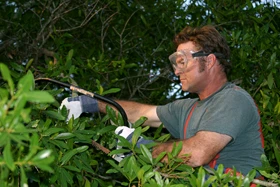
 Booms, harnesses, chainsaws, crews and, on top of that, a several ton tree – a lot goes into cutting down a tree, which means the upmost safety and communication protocols need to be followed to keep contractors, crews and the public out of danger. Here are some safety measures for chainsaws and aerial lifts that every novice and expert needs to remember when cutting down trees.
Booms, harnesses, chainsaws, crews and, on top of that, a several ton tree – a lot goes into cutting down a tree, which means the upmost safety and communication protocols need to be followed to keep contractors, crews and the public out of danger. Here are some safety measures for chainsaws and aerial lifts that every novice and expert needs to remember when cutting down trees.
Chainsaws. Chainsaws can be used for jobs large and small, in the tree or on the ground. But the operating procedure and hazards virtually remain the same. To avoid hazards and risks such as kickback, burns and cuts from the moving saw chain, take these points into consideration.
1. Learn the machine: The operator should follow the manufacturer’s safety instructions and only use the equipment if the chainsaws safety devices are in proper working order. An operator should demonstrate equipment proficiency on the ground before using it in a tree.
2. Proper protection: Personal protective equipment is a must. Among the PPE recommended is gloves, ear plugs, hard hats, chaps, boots and goggles.
3. Getting started. The chainsaw engine should only be started after all other arborists and workers are clear from the area and the operator has a firm stance. The operator should hold the chainsaw firmly with two hands, keeping the thumb and fingers wrapped around the handle. The body of the operator should be entirely to the left of the equipment so that it’s out of the path of the saws upward movement should it kick back.
4. Moving around and shutting down: If walking with the chainsaw, the chain brake should be engaged or the engine should be shut off. The equipment should always be carried in a manner that will prevent the operator from coming in contact with the cutting chain or muffler. Also, the chain brake should be engaged or shut off before the chainsaw is set down.
5. Tree techniques. If working in a tree, the arborist should ensure a chainsaw weighing more than 15 pounds should be made safe against falling. For example, the chainsaw should be supported by a separate line or lanyard.
Aerial lifts. Aerial lifts allow arborist to tackle high and hard to reach portions of the tree. But being in a bucket can be just as dangerous as working on the ground. The potential risks involved in using an aerial lift include equipment failure, falling from the bucket, hydraulic leak and electricity lines.
1. Protective wear. When using an aerial lift, the arborist in the lift should be dressed with goggles, a hard hat, boots and fall protection. The leading cause of serious accidents with aerial lifts involves the person in the bucket not wearing fall protection. Good fall protection is a full body harness with a shock-absorbing lanyard attached to it. The harness then snaps to the bucket tuck anchor point.
2. Check then use. Before using an aerial lift, the manufacturer’s daily checklist should be used to inspect the truck and the lift for any problems or potential problems.
3. Use bucket wisely. Booms, buckets or any other part of the aerial device should not make contact or approach the minimum distance suggested with electrical wires, poles or similar conductive objects. Also, the aerial device should not be used to hoist, lift or lower materials or tree parts unless it is specifically designed to handle those operations.
4. Understand the hydraulics. When using and performing maintenance on an aerial lift, the equipment’s hydraulic system needs to be taken into account. Hydraulic tools should be disconnected when being serviced or adjusted.
To avoid flying particles of whipping hydraulic hoses, pressure should be released before connections are broken, except in cases where quick-acting connectors are used. Also, the flash point of hydraulic fluid should meet the minimum set by the manufacturer.
While these steps may seem basic, they should be continually communicated to ensure safety on the job site.
Editor’s note: The following piece is reprinted from the TCIA Tailgate Safety Program, which facilitates and enhances training efforts. Additionally, because OSHA requires employers to document that they provide safety training, the TCIA Tailgate Program provides for training documentation.
The current edition of the TCIA Tailgate Safety manual features 80 sessions covering workplace scenarios likely to cause harm. Each session includes trainer instructions, reproducible handouts and quick comprehension tests. Use the test results for OSHA safety training documentation.The program can be used for on-the-job lessons, covers multiple employees and is available in Spanish. For more information or to order the program, visit bit.ly/treeprogram.

Explore the April 2012 Issue
Check out more from this issue and find your next story to read.
Latest from Lawn & Landscape
- ExperiGreen, Turf Masters Brands merge
- EquipmentShare cuts ribbon on new Maryland branch
- Strathmore acquires Royal Tree Service in Montreal
- In a new direction
- The December issue is now live
- Ignite Attachments debuts 80-inch, severe-duty bucket
- EquipmentShare breaks ground on Roswell branch
- NaturaLawn of America adds Schwartz, Medd to operations team





